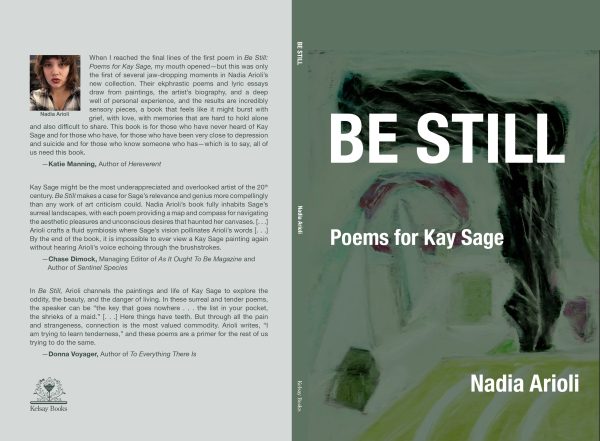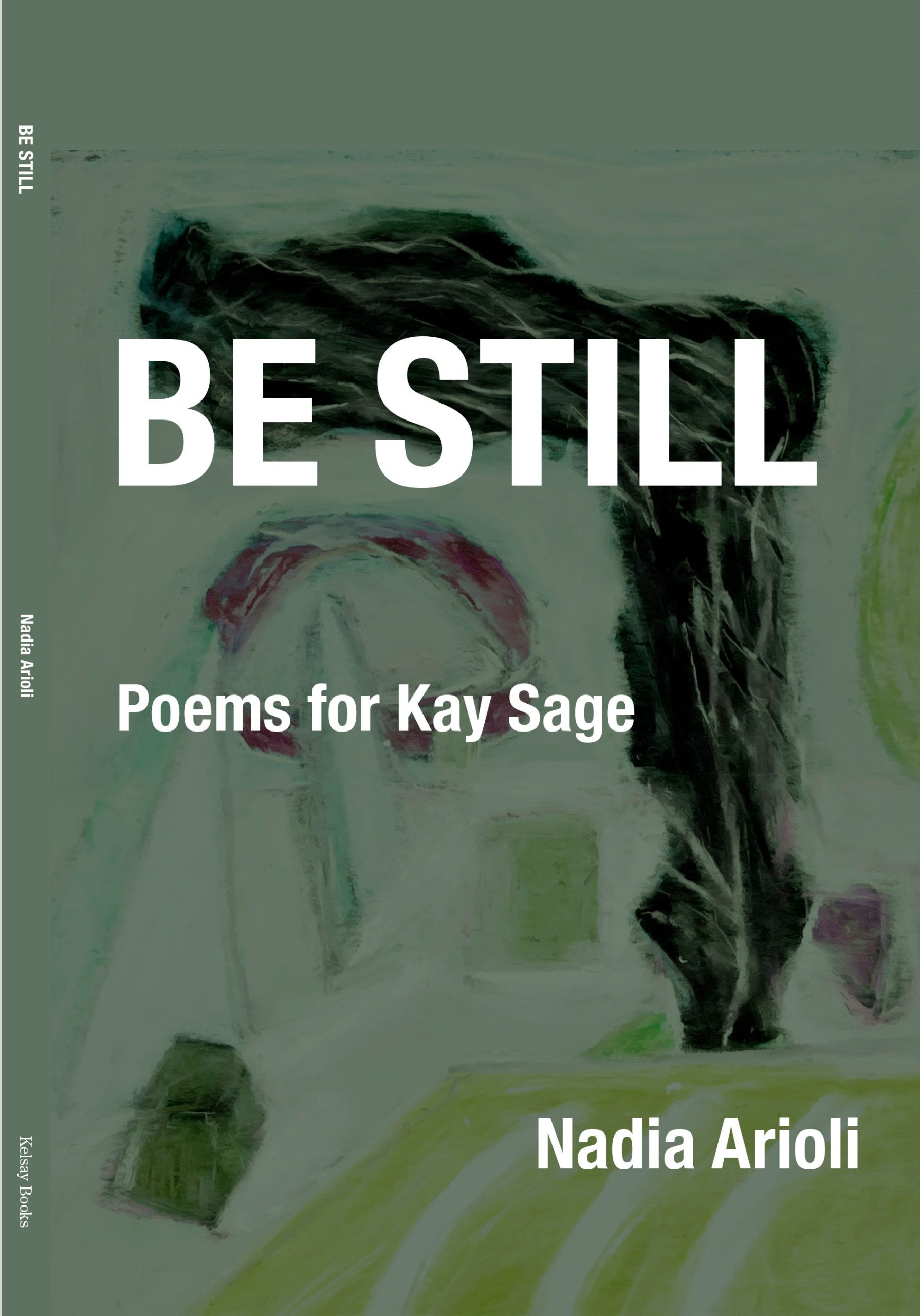Gyroscope Review interviewed poet Nadia Arioli about her new book, Poems for Kay Sage. This wonderful collection of poems is based around the paintings of Surrealist painter Kay Sage. You can find Nadia’s book on Kelsay Books website HERE, and look at twenty of Kay Sage’s paintings on the WikiArt site.
Poems for Kay Sage by Nadia Arioli Interview
GR: How did you come up with the idea for Poems for Kay Sage?
NA: I encountered her painting “I Saw Three Cities” at the Phoenix Art Museum circa 2002, when I was around twelve years old. I looked at the plaque and committed to memorizing her name—which, thankfully, is pretty easy to remember. I then forgot for fifteen years. One day, I thought, who was that painter again? And dug around in my memory until I pulled her out. The reason I decided to write about her was that no one seemed to know about her or care. In that surrealist exhibit from my childhood, she only had one painting in the whole thing and that was the one I remembered. I wanted people to know who she was. It was also important for me to write about something I love—and I really love her paintings, the stillness, the precision.
The funny thing is, I only meant to write one poem—the poem for “I Saw Three Cities.” Things got wildly out of hand because I fell in love with her other paintings too. I wrote poems for her paintings I could find online. When Stephen Miller published her Catalogue Raison (Sage’s complete visual works), I spent more money than I had on that book. I picked out the paintings that spoke to me the most or were of biographical significance.
GR: Why did you use Kay Sage as an inspiration? What about Kay Sage’s paintings attracted you?
NA: I liked how still and foreboding her paintings are. They look straightforward. Unlike, say, a Dali, there are no melting clocks or giant phalluses or grasshoppers. Rather, the landscapes are architectural elements that could really exist but are too frozen in time.
I was also drawn to Sage’s life. She was overlooked, dismissed, and forgotten, largely for being female and married to a famous painter. She suffered tremendous loss and depression. It was important for me to not romanticize sorrow in the life of the artist. Lots of people suffer; only one person made Kay Sage paintings about it.
GR: Can you explain to readers about your working process to come up with the poems for Poems for Kay Sage? Was it hard to begin, or did the poems flow organically once you got started?
NA: It wasn’t too tricky to begin. Once I wrote the poem for “I Saw Three Cities,” I thought, hm, I wonder what else she’s painted. Once I had her catalog, I went through chronologically. The book is also arranged chronologically relative to painting. That was the constraint. I work best with constraint and freedom—so I was sure to vary the poems, rather than have them all strictly descriptively ekphrastic. (although I enjoy those poems too). I wove in her biography, my biography, myth, recipes, and dialogue. In the poem published in Gyroscope Review, I drew on the legend of sin eaters and the life-cycle of a crab.
GR: I loved the descriptions you gave at the end of the book on the paintings. Did you read Kay Sage’s autobiography China Eggs in preparation for your writing and to get a feel for the woman behind the paintings?
NA: Thank you! China Eggs goes for more money than I earn, alas. But I did read everything I could about the artist and from the artist online. And Miller’s book did contain several illuminating essays.
GR: Is there an order to which you wrote your poems? Did you set out to write a poem for each of Kay Sage’s paintings by putting an image in front of you and contemplating it?
NA: I wrote poems for the paintings I could find online, and then went back and wrote chronologically for the paintings in Miller’s book. And you guessed it—I kept the painting in front of me while I let things steep, literally when I could, or in my mind’s eye.
GR: Do you think women Surrealist painters have been overshadowed by surrealists like Salvador Dali and Rene Magritte? Or was it the male domination of the art world in the 1940s that pushed Kay Sage to the background?
NA: Yes, both! I feel like the women were constantly overshadowed by Dali et al. And yet more people would be able to name, say, Tanning or Varos than Sage. I think two things were against Sage in particular: she was married to Surrealist painter Yves Tanguy, so she got the Kahlo treatment while she was alive. (“O the little wife is a little painter herself too. Isn’t it cute? What the wife is doing?” etc.) The other force against her was that Andre Breton, the self-appointed leader of the Surrealist movement, actively disliked her. His reasons were never quite clear, but most art historians landed on the thought Sage was too moneyed and too female. (How can one be too female? I’m not sure, but I hope to achieve this one day.)
GR: How did the surrealist dreamwork aspect of Kay Sage’s paintings influence your poetry?
NA: I would say that her paintings have a dream-like quality to them for sure, but they were more like imaginary places than a sequence from the subconscious, if that makes sense. I think a poem is also an imaginary place—a small room where things are moving and still all at once.
With a few exceptions, I steered away from Surrealist imagery. I love a good Surreal image—but it’s not authentic to me, particularly, as an artist. The other reason is that I felt writing Surreal poetry about Surreal paintings was a little too on-the-nose, which is presently melting and turning into a locust—not that Sage would ever.
GR: Do you have a favorite painting (or two) by Kay Sage? What drew you to the painting?
NA: Let me describe to you “I Saw Three Cities.” When I first saw the painting, I thought the title was from the Book of Revelations: I, John, saw three cities. Research would suggest this is not the case. And yet, there is something so apocalyptic about it. A figure draped in cloth stands headless in gray-green light looking out into pyramids. The painting is small, unassuming, and quite the way the world is quiet after a bomb goes off. It’s all about that paradox: Are still things really still?
GR: Is there a good place online to look at Kay Sage paintings? What art galleries hold her works?
NA: Her paintings are all over. I know the Worchester Art Museum has some. So does Princeton. TheArtStory.com was a great resource, both for paintings and for biography.
GR: What else can you tell us about your writing process in coming up with this book?
NA: It was important that this collection had an arc to it. And I don’t mean a straight beginning-middle-end, which would be a silly thing to try to do in a poetry book about a Surrealist. I mean the way a good concept album tells an emotional arc, ending on the tonic. To do that. I had to go back and rework some poems, such that there were images that operate on the book-level (as opposed to the poem-level).
GR: Anything else you’d like to say about your writing, your publications, or Kay Sage?
NA: Oh gosh. I’m not sure. I guess write about what you love. And you can make your collections as wild and idiosyncratic as you like. Can you write 138 pages about an obscure artist from almost 100 years ago? Sure! Why not! It’s not illegal! And you might just be lucky enough to have people who want to publish and read your work. I’ve been very blessed in that regard.
GR: Thank you Nadia Arioli, for the wonderful book of poetry on Kay Sage, and for your insights into making it come to life.
You can find Nadia’s book Poems for Kay Sage on Kelsay Books website HERE
Nadia Arioli is the co-founder and editor-in-chief of Thimble Literary Magazine and a multi-disciplinary artist. Arioli’s poetry has been nominated for Best of the Net three times and can be found in Cider Press Review, Rust + Moth, San Pedro Review, McNeese Review, Whale Road Review, West Trestle Review, As It Ought To Be, Voicemail Poems, Bombay Literary Magazine, and other publications. Essays have been nominated for Best of the Net and the Pushcart and can be found in Hunger Mountain, Heavy Feather Review, Angel Rust, and elsewhere. Collages and scribblings have been featured as the cover of Permafrost, as artist of the month for Kissing Dynamite and Rogue Agent, and in Poetry Northwest.

Read other Gyroscope Review Interviews
Interview with Poet Marc Alan Di Martino
Interview with Poet Carol Deering
Interview with Poet Kendall Mallon
Interview with Poet Tricia Knoll
Also—Search under National Poetry Month Interview Series 2018 for 30 days of poet interviews.
